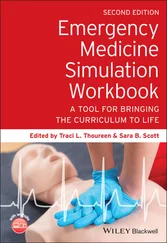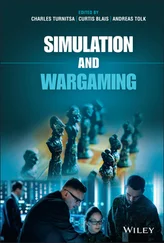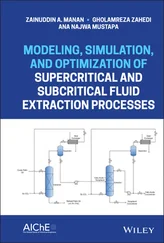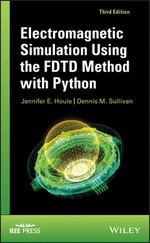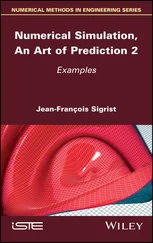Alexander Peiffer - Vibroacoustic Simulation
Здесь есть возможность читать онлайн «Alexander Peiffer - Vibroacoustic Simulation» — ознакомительный отрывок электронной книги совершенно бесплатно, а после прочтения отрывка купить полную версию. В некоторых случаях можно слушать аудио, скачать через торрент в формате fb2 и присутствует краткое содержание. Жанр: unrecognised, на английском языке. Описание произведения, (предисловие) а так же отзывы посетителей доступны на портале библиотеки ЛибКат.
- Название:Vibroacoustic Simulation
- Автор:
- Жанр:
- Год:неизвестен
- ISBN:нет данных
- Рейтинг книги:3 / 5. Голосов: 1
-
Избранное:Добавить в избранное
- Отзывы:
-
Ваша оценка:
- 60
- 1
- 2
- 3
- 4
- 5
Vibroacoustic Simulation: краткое содержание, описание и аннотация
Предлагаем к чтению аннотацию, описание, краткое содержание или предисловие (зависит от того, что написал сам автор книги «Vibroacoustic Simulation»). Если вы не нашли необходимую информацию о книге — напишите в комментариях, мы постараемся отыскать её.
Learn to master the full range of vibroacoustic simulation using both SEA and hybrid FEM/SEA methods Vibroacoustic Simulation
Vibroacoustic Simulation
Vibroacoustic Simulation
Vibroacoustic Simulation — читать онлайн ознакомительный отрывок
Ниже представлен текст книги, разбитый по страницам. Система сохранения места последней прочитанной страницы, позволяет с удобством читать онлайн бесплатно книгу «Vibroacoustic Simulation», без необходимости каждый раз заново искать на чём Вы остановились. Поставьте закладку, и сможете в любой момент перейти на страницу, на которой закончили чтение.
Интервал:
Закладка:
14 7 Coupled Systems 7.1 Deterministic Subsystems and their Degrees of Freedom7.2 Coupling Deterministic Systems7.2.1 Fluid Subsystems7.2.2 Fluid Structure Coupling7.2.3 Deterministic Systems Coupled to the Free Field7.3 Coupling Random Systems7.3.1 Power Input to System ( m ) from the n th Reverberant Field7.3.2 Power Leaving the ( m )th Subsystem7.3.3 Some Remarks on SEA Modelling7.4 Hybrid FEM/SEA Method7.4.1 Combining SEA and FEM Subsystems7.4.2 Work Flow of Hybrid Simulation7.5 Hybrid Modelling in Modal CoordinatesBibliography
15 8 Coupling Loss Factors 8.1 Transmission Coefficients and Coupling Loss Factors8.1.1 τ-η Relationship from Diffuse Field Assumptions8.1.2 Angular Averaging8.2 Radiation Stiffness and Coupling Loss Factors8.2.1 Point Radiation Stiffness8.2.2 Point Junctions8.2.3 Area Radiation Stiffness8.2.4 Area Junctions8.2.5 Line Radiation Stiffness8.2.6 Line Junctions8.2.7 SummaryBibliography
16 9 Deterministic Applications 9.1 Acoustic One-Dimensional Elements9.1.1 Transfer Matrix and Finite Element Convention9.1.2 Acoustic One-Dimensional Networks9.1.3 The Acoustic Pipe9.1.4 Volumes and Closed Pipes9.1.5 Limp Layer9.1.6 Membranes9.1.7 Perforated Sheets9.1.8 Branch Lumped Elements9.1.9 Boundary Conditions9.1.10 Performance Indicators9.2 Coupled One-Dimensional Systems9.2.1 Change in Cross Section9.2.2 Impedance Tube9.2.3 Helmholtz Resonator9.2.4 QuarterWave Resonator9.2.5 Muffler System9.2.6 T-Joint9.2.7 Conclusions of 1D-Systems9.3 Infinite Layers9.3.1 Plate Layer9.3.2 Lumped Elements Layers9.3.3 Fluid Layer9.3.4 Equivalent Fluid Fiber Material9.3.5 Performance Indicators9.3.6 Conclusions on Layer Formulation9.4 Acoustic Absorber9.4.1 Single Fiber Layer9.4.2 Multiple Layer Absorbers9.4.3 Absorber with Perforate9.4.4 Single Degree of Freedom Liner9.5 AcousticWall Constructions9.5.1 Double Walls9.5.2 Limp Double Walls with Fiber9.5.3 Two Plates with Fiber9.5.4 Conclusion on Double WallsBibliography
17 10 Application of Random systems 10.1 Frequency Bands for SEA Simulation10.2 Fluid Systems10.2.1 Twin Chamber10.3 Algorithms of SEA10.4 Coupled Plate Systems10.4.1 Two Coupled Plates10.5 Fluid-Structure Coupled Systems10.5.1 Twin Chamber10.5.2 Noise Control Treatments10.5.3 Transmission Loss of Trimmed Plate10.5.4 Free Field Radiation into Half Space10.5.5 Isolating Box10.5.6 Rules of Noise ControlBibliography
18 11 Hybrid Systems 11.1 Hybrid SEA Matrix11.2 Twin Chamber11.2.1 Step 1 – Setting up System Configurations11.2.2 Step 2 – Setting up System Matrices and Coupling Loss Factors11.2.3 Step 3 – External Loads11.2.4 Step 4 – Solving System Matrices11.2.5 Step 5 – Adding the Results11.3 Trim in Hybrid Theory11.3.1 The Trim Stiffness Matrix11.3.2 Hybrid Modal Formulation of Trim and Plate11.3.3 Modal Space11.3.4 Plate Example with TrimBibliography
19 12 Industrial Cases 12.1 Simulation Strategy12.1.1 Motivation12.1.2 Choice of Simulation Method12.2 Aircraft12.2.1 Excitation12.2.2 Simulation Strategy12.2.3 Fuselage Sidewall12.2.4 SEA Model of a Fuselage Section12.3 Automotive12.3.1 Simulation Strategy12.3.2 Excitation12.3.3 Rear Carbody12.3.4 Full Scale SEA Models12.4 Trains12.4.1 Structural Design12.4.2 Interior Design12.4.3 Excitation and Transmission Paths12.4.4 Simulation Strategy12.4.5 Applications to Rail Structures – Double Walls12.4.6 Carbody Sections – High Speed Applications12.5 SummaryBibliography
20 13 Conclusions and Outlook 13.1 Conclusions13.2 What Comes Next?13.3 Experimental Methods13.3.1 Transfer Path Analysis13.3.2 Experimental Modal Analysis13.3.3 Correlation Between Test and Simulation13.3.4 Experimental or Virtual SEA13.4 Further Reading on Simulation13.4.1 Advances in SEA and Hybrid FEM/SEA Methods13.5 Energy Flow Method and Influence Coefficient13.5.1 More Realistic Systems13.5.2 Anisotropic Material13.5.3 Porous Elastic Material13.5.4 Composite Material13.5.5 Sandwich13.5.6 Shell Theory13.5.7 Wave Finite Element Method (WFE)13.5.8 The High Frequency Limit13.6 Vibroacoustics Simulation SoftwareBibliography
21 A Basic Mathematics A.1 Fourier AnalysisA.1.1 Fourier SeriesA.1.2 Fourier TransformationA.1.3 Dirac Delta FunctionA.1.4 Signal PowerA.1.5 Fourier Transform of Real Harmonic SignalsA.1.6 Useful Properties of the Fourier TransformA.1.7 Fourier Transformation in SpaceA.2 Discrete Signal AnalysisA.2.1 Fourier Transform of Discrete SignalsA.2.2 The Discrete Fourier TransformA.2.3 WindowingA.3 Coordinate Transformation of Discrete Equation of Motion Bibliography
22 B Specific Solutions B.1 Second Moments of AreaB.2 Wave TransmissionB.2.1 The Blocked Forces InterpretationB.2.2 BendingWavesB.2.3 LongitudinalWavesB.2.4 ShearWavesB.2.5 In-planeWavesB.3 Conversion Formulas of Transfer MatrixB.3.1 Derivation of Stiffness Matrix from Transfer Matrix Bibliography
23 C Symbols
24 Index
25 End User License Agreement
List of Illustrations
1 Chapter 2Figure 2.1 Histogram for the height...Figure 2.2 Histogram of triglycerides in...Figure 2.3 Bar chart of blood...Figure 2.4 Comparison of three “...Figure 2.5 Illustration of the statistical table.Figure 2.6 Bar chart of the...Figure 2.7 Percentage bar chart of...Figure 2.8 Pie chart of the...Figure 2.9 Stem-and-leaf plot...Figure 2.10 Boxplot of the iodine...Figure 2.11 Scatterplot of the correlation...Figure 2.12 Line graph of the...Figure 2.13 Semi-logarithmic line graph...Figure 2.14 Histograms of BMI and...
2 Chapter 3Figure 3.1 Venn diagram showing the...Figure 3.2 Venn diagrams showing the...Figure 3.3 Venn diagram showing the...Figure 3.4 Venn diagram showing event...Figure 3.5 Venn diagrams showing the...Figure 3.6 Venn diagram showing mutually...
3 Chapter 4Figure 4.1 Cumulative distribution function of...Figure 4.2 Graphical characteristics of the...Figure 4.3 Graphical characteristics of the...
4 Chapter 5Figure 5.1 Simulated height distribution of...Figure 5.2 Illustration of the cdf...Figure 5.3 Illustration of the pdf...Figure 5.4 Illustration of the empirical...Figure 5.5 Illustration of the standardization...Figure 5.6 Normal probability plot of...Figure 5.7 Diagram of the normal...Figure 5.8 Normal approximation...Figure 5.9 Normal approximation...
5 Chapter 6Figure 6.1 Sampling distribution of...Figure 6.2 Sampling distribution of...Figure 6.3 Comparison of the t...Figure 6.4 X 2distribution...Figure 6.5 Frequency distribution of...Figure 6.6 Frequency distribution of the...Figure 6.7 Illustration of critical values...Figure 6.8 Illustration of critical values...Figure 6.9 F distribution...Figure 6.10 Illustration of critical values...
6 Chapter 7Figure 7.1 Illustration of the rejection...Figure 7.2 Illustration of the...Figure 7.3 Illustration of the two...Figure 7.4 Illustration of the rejection...Figure 7.5 Illustration of power for...Figure 7.6 Illustration of power for...Figure 7.7 Illustration of rejection and...
7 Chapter 8Figure 8.1 Illustration of the rejection...Figure 8.2 Illustration of the...Figure 8.3 Illustration of the rejection...Figure 8.4 Illustration of the...
8 Chapter 9Figure 9.1 Paw-licking durations (s...Figure 9.2 Illustration of rejection and...Figure 9.3 Illustration of p...Figure 9.4 Illustration of rejection and non-rejection regions for LSD- t Figure 9.5 P —...
9 Chapter 10Figure 10.1 Illustration of main effect...Figure 10.2 Testing guidelines for a...Figure 10.3 Trend of changes in...Figure 10.4 Illustration of 2×...
10 Chapter 11Figure 11.1 Illustration of rejection and...Figure 11.2 Possible four-fold tables...
11 Chapter 13Figure 13.1 Scatterplot of the weight...Figure 13.2 Variation decomposition of dependent...
Читать дальшеИнтервал:
Закладка:
Похожие книги на «Vibroacoustic Simulation»
Представляем Вашему вниманию похожие книги на «Vibroacoustic Simulation» списком для выбора. Мы отобрали схожую по названию и смыслу литературу в надежде предоставить читателям больше вариантов отыскать новые, интересные, ещё непрочитанные произведения.
Обсуждение, отзывы о книге «Vibroacoustic Simulation» и просто собственные мнения читателей. Оставьте ваши комментарии, напишите, что Вы думаете о произведении, его смысле или главных героях. Укажите что конкретно понравилось, а что нет, и почему Вы так считаете.


